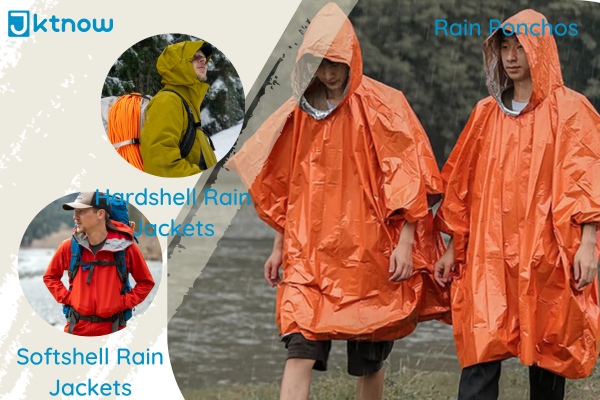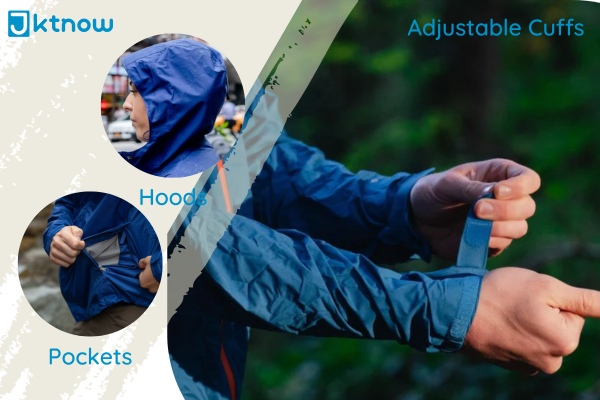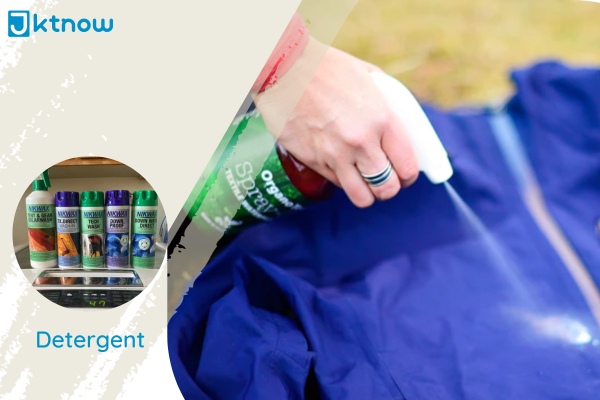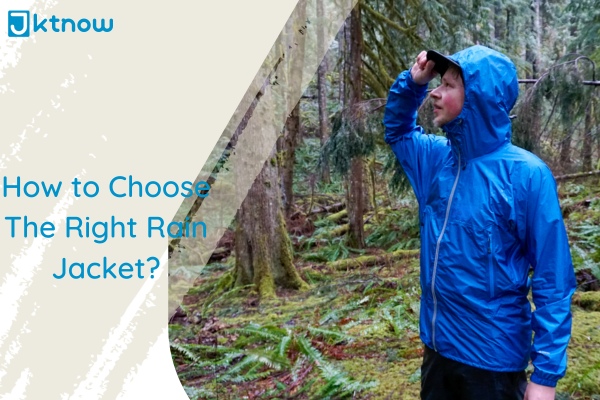Choosing the right rain jacket is essential for staying dry and comfortable during rainy weather. With so many options on the market, it can be overwhelming to make the best choice. Fear not! In this comprehensive blog, I’ll walk you through everything you need to know to choose a rain jacket that suits your needs and preferences perfectly.
Understanding Rainwear Basics
Understanding waterproof jacket basics is the first step towards making an informed choice when you choose a rain jacket.
At its core, a rain jacket is your shield against wet weather. It is a protective barrier, keeping you dry and comfortable when rain starts pouring. These jackets are typically crafted from specialized waterproof materials, such as Gore-Tex, nylon, or PVC, designed to repel water and prevent it from seeping through to your clothing.
Whether hiking in the wilderness, commuting to work, or running errands on a rainy day, a dependable rain jacket is an essential piece of outerwear that can make all the difference in your comfort and overall experience. So, let’s dive deeper into the world of rain jackets and equip you with the knowledge you need to choose the best suits your needs.
Types of Rain Jackets
Rain jackets come in various styles, each with its features. Most rain shell fabrics use a 2-layer, 2.5-layer, and 3-layer construction, even though nearly all of them only look like a single layer when you hold them at the store because they are tightly sandwiched and laminated. Understanding the different types can help you decide to choose a rain jacket.

Hardshell Rain Jackets
Hardshell rain jackets are designed for ultimate protection in the harshest weather conditions. These jackets are typically constructed from durable, waterproof materials that withstand heavy rain, wind, and snow. They excel in keeping you dry in extreme outdoor environments.
Hardshell jackets often feature fully taped seams, watertight zippers, and adjustable hoods for maximum rain protection. They are the go-to choice for mountaineering, hiking, and winter sports when staying dry is paramount.
Softshell Rain Jackets
Softshell rain jackets prioritize flexibility and breathability. Unlike hard shells, they are more comfortable for activities requiring a more excellent range of motion, such as hiking, cycling, or everyday wear.
Softshell jackets are made from stretchy, breathable, water-resistant materials rather than fully waterproof. They are ideal for light to moderate rain and balance weather protection and comfort. Some softshells also include DWR coatings for added water resistance.
Rain Ponchos
Rain ponchos are simple, lightweight, and affordable for staying dry in wet conditions. They are often made from water-resistant materials like plastic or nylon and are designed to be thrown over your body to shield you from the rain.
Rain ponchos offer quick and easy rain protection, making them convenient for outdoor events, festivals, or unexpected rain showers. While they may not provide as much coverage or durability as traditional rain jackets, they are compact and easy to carry, making them a popular choice for on-the-go rain protection.
Material Matters of Waterproof Jacket
The material of your rain jacket is pivotal in determining its waterproof and breathable qualities. The critical component of your rainwear fabric is a coating or membrane that does the technological trick of blocking rain while allowing sweat vapor to escape. Let’s dive into some common rain jacket materials.

Gore-Tex
Gore-Tex is renowned for its exceptional performance in rain jackets. It’s a high-performance material known for its breathability and waterproofing capabilities. Gore-Tex’s microscopic pores allow moisture vapor (like sweat) to escape while preventing raindrops from getting in. This means you stay dry from the rain outside and comfortable from within.
Gore-Tex rain jackets are perfect for those who demand top-tier performance in various weather conditions, making them a popular choice for outdoor enthusiasts and adventurers.
Nylon
Nylon rain jackets are prized for their lightweight and durable qualities. It is a synthetic material with good water resistance, making it an excellent choice for everyday use and light outdoor activities. Its lightweight nature ensures you can easily pack it for unexpected showers, while its durability ensures a long lifespan.
Nylon rain jackets are versatile and suitable for various weather conditions, making them a dependable choice for urban commuters and casual hikers.
PVC
Polyvinyl Chloride (PVC) is renowned for its exceptional waterproof characteristics, rendering it a favored option for robust rain protection. Fully waterproof jackets crafted from PVC are frequently employed in demanding industrial environments and for enduring heavy rainfall. While they excel in keeping you dry, they may lack the breathability of materials like Gore-Tex.
It is a practical choice to wear a PVC rain jacket when you need uncompromising waterproofing, such as when working outdoors in extremely wet conditions. However, they may not be the most breathable option for prolonged activities.
Waterproofing Technologies
Rain jackets employ various technologies to enhance their waterproofing capabilities. These technologies contribute to the jacket’s overall effectiveness in repelling rain.

Seam Sealing
Seam sealing is a crucial waterproofing technology used to construct rain jackets. The seams of a rain jacket are the most vulnerable points where water can penetrate if not adequately addressed. Seam sealing involves applying a waterproof tape or adhesive along the seams, effectively sealing off any potential entry points for moisture. This process ensures that even the tiniest needle holes created during the stitching are impervious to water.
Without seam sealing, rain could seep through the seams and make you feel damp, defeating the purpose of your rain jacket. When you choose a rain jacket, check if the seams are fully taped or sealed for maximum waterproofing protection, especially if you plan to be in heavy rain or wet conditions.
DWR Coatings
Durable Water Repellent (DWR) coatings are another essential element of rain jacket waterproofing. These coatings are applied to the jacket’s outer fabric, making the surface highly water-resistant. DWR coatings work by causing water to bead up and roll off the jacket instead of being absorbed into the fabric. This prevents the jacket’s outer layer from becoming saturated, which can lead to a loss of breathability and comfort.
While DWR coatings are highly effective, they can wear off over time due to regular use and exposure to the elements. A jacket’s surface fabric can get wet when the DWR wears off. The underlying membrane or coating will still keep water out, but the soaked surface fabric slows the movement of sweat vapor to the outside.
To maintain the water-repellent properties of your rain jacket, consider periodic reapplication of DWR coating or look for jackets that offer this feature. Proper care and maintenance of DWR coatings will help ensure your rain jacket continues to perform at its best in wet conditions.
Breathability and Ventilation
Breathability prevents you from feeling sweaty and clammy inside your rain jacket. Look for features that promote air circulation and moisture management, such as:

Pit Zips
Pit zips, short for pit ventilation zippers, are a clever design feature in many rain jackets. These zippered vents are placed under the arms, where your body generates the most heat and moisture. When the weather or your activity level heats up, you can unzip these vents to allow hot air and moisture to escape, preventing that stifling, sweaty feeling inside the jacket.
Pit zips are particularly valuable during high-intensity activities like hiking or cycling, as they help regulate your body temperature and keep you fresh and comfortable throughout your adventure.
Mesh Linings
Mesh linings are another feature that enhances the breathability and comfort of a rain jacket. These thin, lightweight fabric layers are often strategically placed on the jacket’s interior. Mesh linings wick moisture away from your body and help it evaporate quickly, maintaining a dry and comfortable interior environment.
Additionally, they act as a barrier, ensuring that the inner surface of the jacket doesn’t adhere to your skin. When you choose a rain jacket with mesh linings, you’re making an excellent decision if you prioritize staying dry while also enjoying comfort, especially during activities that demand a broad range of motion.
Additional Features
Rain jackets often come with extra features to enhance their functionality:

Hoods
Hoods are essential in rain jackets, providing added protection for your head and face when rain is pouring down. Many rain jackets come with adjustable hoods, allowing you to fine-tune the fit for maximum coverage. A well-designed hood can keep you dry and comfortable, whether caught in a sudden downpour or facing windy conditions.
Pockets
Pockets in rain jackets offer convenience and storage space for your essentials. These pockets can vary in style and placement, including zippered hand pockets, chest pockets, or interior pockets for valuables like smartphones or wallets. Having accessible pockets ensures you can keep your belongings dry while staying organized on the go, whether hiking, commuting, or running errands.
Adjustable Cuffs
Adjustable cuffs are a practical feature that allows you to seal off your sleeves to prevent rain from entering. This feature is handy during heavy rain or when you must keep your hands dry. By customizing the fit of your cuffs, you can adapt your rain jacket to different conditions and stay comfortably dry without compromising mobility. Adjustable cuffs are a small yet valuable detail that can enhance the functionality of your rain jacket.
Care and Maintenance
Proper care and maintenance of your rain jacket are essential to ensure it continues to serve you well in wet conditions. Start by following the manufacturer’s cleaning instructions, typically found on the jacket’s label or included with the packaging. Use a mild detergent and avoid harsh chemicals or fabric softeners, as they can damage the jacket’s waterproof coatings.

When it comes to storage, keep your rain jacket in a cool, dry place away from direct sunlight. Avoid crumpling or folding it for extended periods, weakening the fabric and compromising its waterproofing abilities. Suppose your jacket’s water-repellent DWR (Durable Water Repellent) coating has worn off over time. You can restore it by applying a DWR spray readily available in outdoor gear stores.
Regularly inspect your rain jacket for any signs of wear and tear, such as damaged seams or zippers. Please address any issues promptly to prevent them from worsening. These simple steps ensure your rain jacket remains reliable for staying dry during unexpected showers and downpours.
Conclusion
Selecting the ideal rain jacket need not be an overwhelming endeavor. With the proper knowledge and thoughtful considerations, you can confidently choose a rain jacket that keeps you dry and comfortable, regardless of the weather conditions. Always bear in mind that the perfect rain jacket is the one that aligns seamlessly with your needs and style preferences when you decide to choose a rain jacket.
Get High-Quality Custom Rain Jackets From Jktnow!
Ready to find your perfect rain jacket? Look no further! At Jktnow, we’re your trusted partner in rainwear solutions. As a professional rain jacket manufacturer and wholesaler based in China, we offer a wide range of rain jackets with customizable designs, logos, and materials to suit your needs.
Explore our extensive collection and use our custom services to create the rain jacket that’s just right for you. Don’t let rainy days dampen your spirits—choose Jktnow for the ultimate in rainwear excellence.
FAQs (Frequently Asked Questions)
Q1. Can I use my rain jacket for activities other than hiking or camping?
Absolutely! Rain jackets are versatile and can be used for outdoor and urban activities. Whether commuting to work, running errands, biking, or simply strolling in the city, a good rain jacket will keep you dry and comfortable in various situations.
Q2. How often should I reapply the DWR coating to my rain jacket?
The frequency of reapplying the DWR (Durable Water Repellent) coating on your rain jacket depends on your usage and environmental conditions. As a general guideline, consider reapplying it every season or whenever you notice water no longer beading on the fabric. This maintenance step helps restore the jacket’s water-repellent properties and keeps you dry during rain showers.
Q3. Are custom rain jacket designs available for all types of rain jackets?
Customization options for rain jackets may vary by brand and the type of rain jacket. While many manufacturers offer custom designs, logos, and color choices, it’s advisable to check with the specific brand or manufacturer to confirm the availability of customization options for the type of rain jacket you’re interested in.
Q4. What’s the difference between water-resistant and waterproof rain jackets?
Water-resistant rain jackets can repel light rain and moisture to some extent but may not withstand heavy downpours or prolonged exposure to rain. On the other hand, waterproof rain jackets are designed to keep you dry even in heavy rain and are constructed with materials and features that prevent water penetration. When choosing a rain jacket, it’s essential to consider the level of waterproofing you need based on your intended activities and the expected weather conditions.
Q5. Do rain jackets come with a warranty?
Many reputable rain jacket brands offer warranties to give customers peace of mind. The duration and terms of warranties may vary from one brand to another, so it’s a good idea to check the manufacturer’s warranty policy before purchasing. A warranty can be valuable if your rain jacket experiences manufacturing defects or issues within the specified period. Keep your proof of purchase if you need to make a warranty claim.

